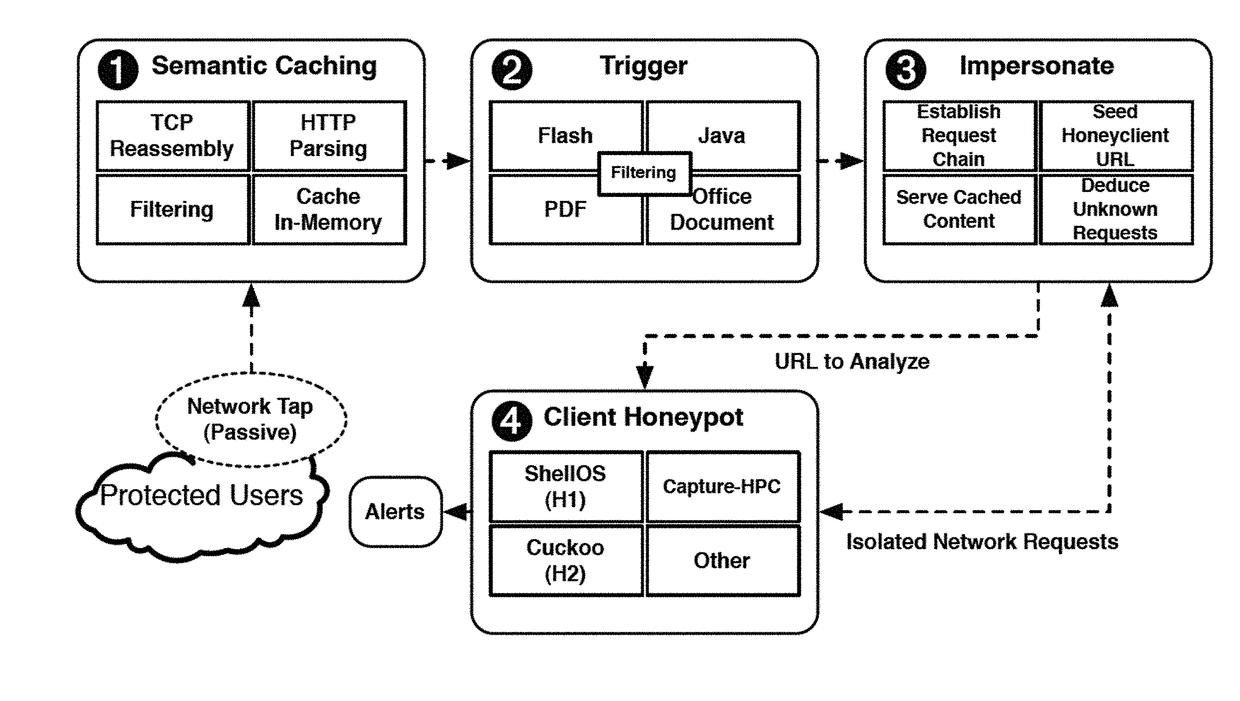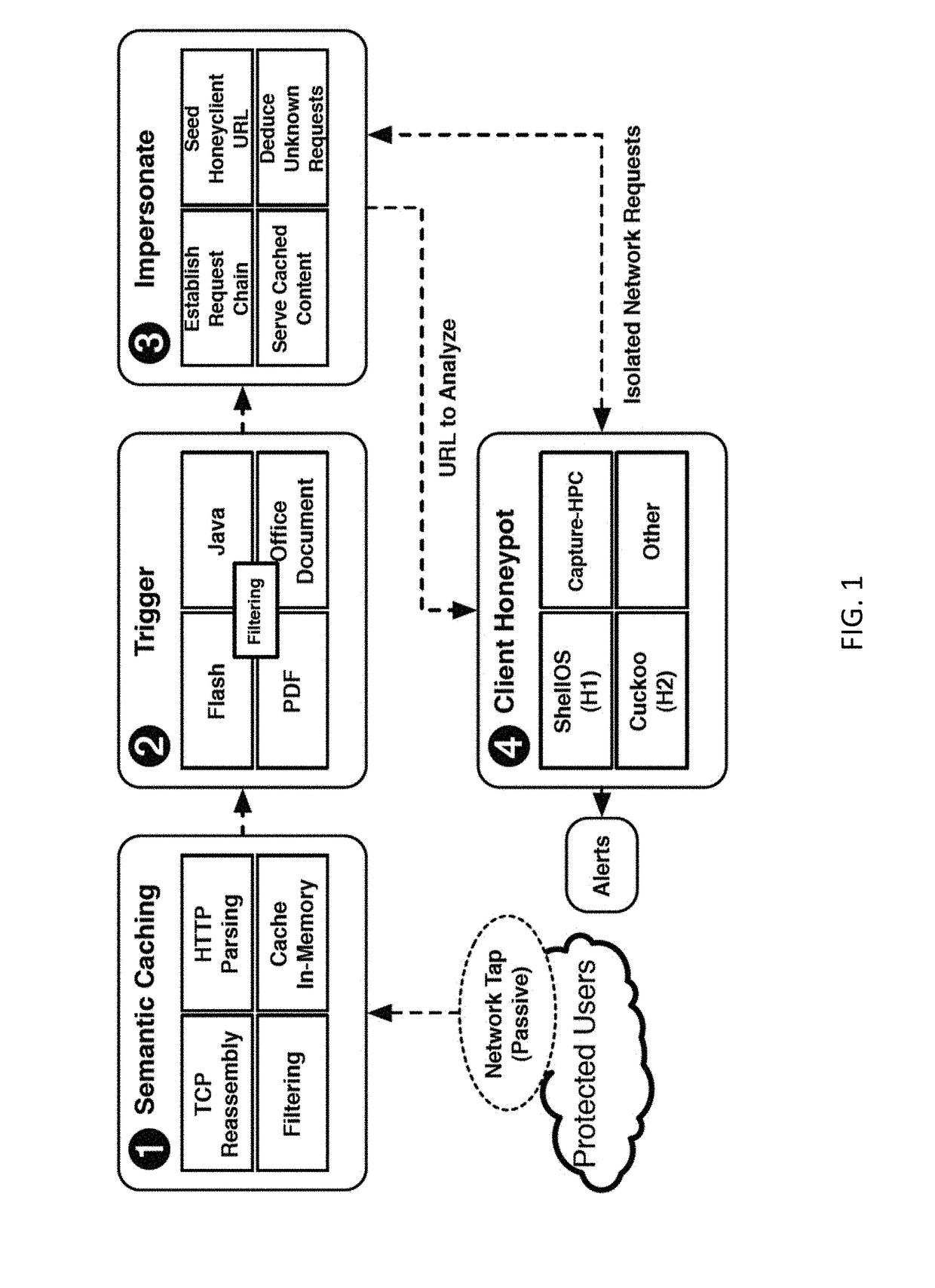These approaches require massive cloud infrastructure to comb
the Internet at scale, and are susceptible to
cloaking and versioning issues [34].
Since the approach analyzes
JAR files in isolation, it is unable to detect malfeasance when parameters are passed into the applet.
Unfortunately,
parsing and executing all
JavaScript that crosses the boundary of a large network is not scalable without some mechanism for pre-filtering all the
noise produced by benign scripts.
Further, simply executing
JavaScript without
interfacing with the surrounding context, such as relevant
HTML and other intertwined contents, makes evading such systems trivial.
Unfortunately, these techniques take broad strokes in terms of specifying suspicious activity.
[23] only disclose that using obfuscated
JavaScript as an indicator leads to a high number of false positives.
These works also require large training sets that are not generally available.
While these techniques are dynamically adaptable due to their use of
machine learning, they still require a priori notions of how malicious code is constructed.
Additionally, highly obfuscated Flash exploits wherein the
obfuscation itself is the only available feature cannot be reliably detected with this approach without false positives (2% in [33]) since
obfuscation is commonly used by benign files.
They also are not effective against zero-day attacks.
Working at scale, however, comes with several pragmatic challenges.
For one, honeyclients are notoriously slow in analysis; however, mechanisms described herein can drastically reduce the amount of traffic analyzed, without basing these mechanisms on preconceived notions as to the innocuity of the traffic in question.
Operating on-the-wire, however, we can not afford this luxury.
The next challenge for the design of such a
system involves intelligently determining whether to apply honeyclient analysis to particular observed URL requests.
Indeed, honeyclient analysis is typically slow, on the order minutes.
These features are effective, but fall short when a new zero-day
exploit surfaces that is not inline with the predefined
feature set.
In short, existing approaches for filtering Flash files take a
blacklisting approach, that unfortunately, are evaded during the period of time when attackers
exploit a new
vulnerability without giving those systems other hints of their malicious intent (e.g., such as multiple
layers of
obfuscation).
The central challenge is to do so without further interaction with either the
client or the server.
The observant reader would note, however, that one can rarely analyze a web-based exploit file like Flash in isolation.
Due to data collection limitations on our
campus network, we are limited to collecting browser information through the User-Agent and X-Flash-Version fields of HTTP requests, which provides browser, OS and Flash versioning information.
The most significant challenge with respect to impersonating the server-side of the connection is that it is the
headless browser and honeyclient—not the original network client—that makes the web requests to the
web cache.
However, H1 may not
handle virtualization checks that are done through JavaScript based filesystem checks (Section V) prior to constructing or unpacking the injected code.
However, we argue that such a comparison against a honeyclient is biased and incorrect in practice—The honeyclients operate with only the general knowledge accumulated over many years, while content-based signature engines update their
knowledge base per each newly observed malicious file.
Indeed, there is little value in
system that does not detect a malicious file at the time it is used to
attack one's network.
We hypothesize that signature engine performance is significantly worse than our on-the-wire honeyclient when comparing it to a signature engine using only those signatures available at the time of the
attack.
More unsettling is that two different instances of the same exploit kit found a year apart still leads to at most 3 signature-engine detections.
Thus, finding a single instance of an exploit file does not appear useful for these engines in finding newer exploit files from the same exploit kit, unless the files are exactly the same.
Unfortunately, with the rapidly moving and
morphing nature of these kits, the instances are no longer active on
the Internet by the time content-based signature engines have a rules to detect them.
We note, however, that our framework only incorporates honeyclient H1 in this experiment due to the sheer volume of Flash files observed.
Indeed, these pages are never meant to be seen by the user, but rather hidden in a small iframe.
Such timeouts can be risky for the attacker because the user of the targeted
machine could surf to a new page before the
delay has transpired.
Thwarting such attacks remains an active area of research and this limitation is not specific to our approach [16].
Such an attack would be difficult to detect in a framework such as ours, which is designed to work without manual intervention.
Lastly, an attacker could try to overwhelm the framework by loading several Flash files at once with only one of the files being malicious.
 Login to View More
Login to View More  Login to View More
Login to View More 


